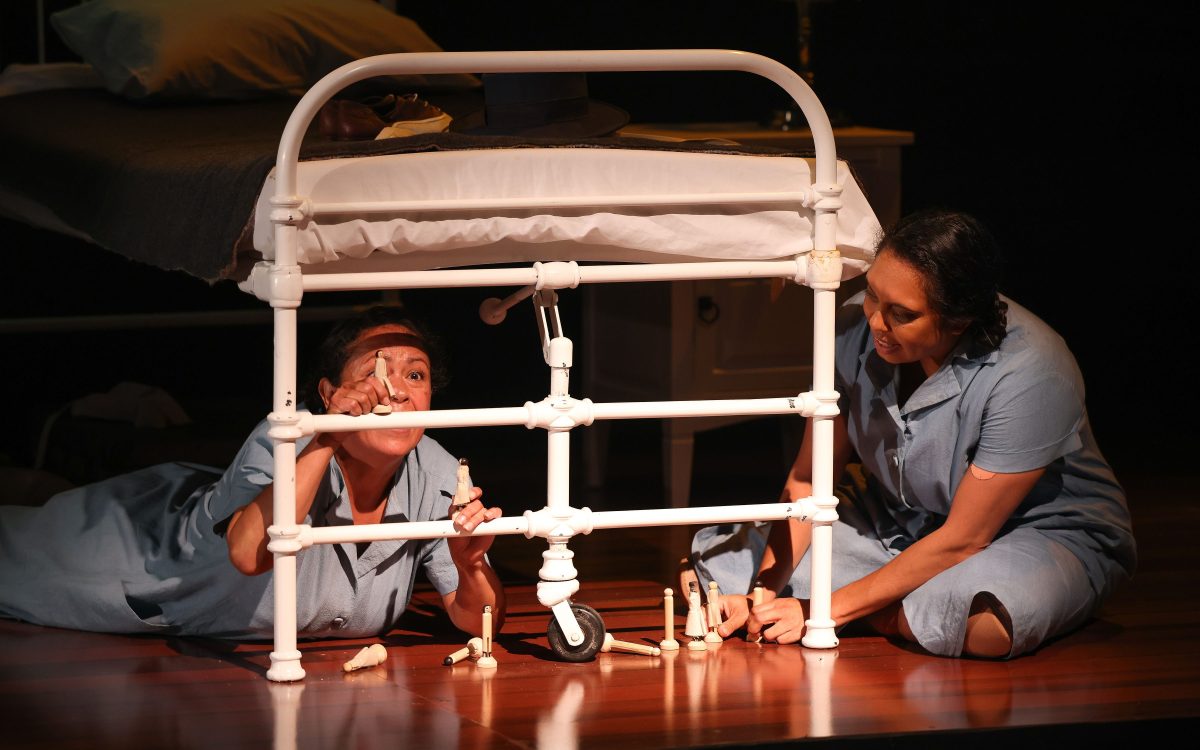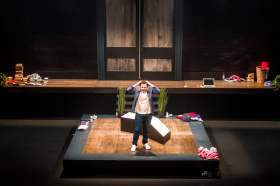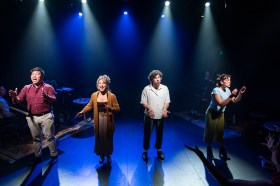The story of how Ruby and her daughter, Ruthie, are ripped apart through the abhorrent race-based policies of forced removal is the basis for this poignant and deeply moving play, Is That You, Ruthie?. From 1930 to 1957, mother and daughter were forcibly separated and although they tried to rebuild what was taken from them, their bond would be forever altered because of the trauma inflicted on them by the government’s cruel legacy.
With acclaimed writer and director Leah Purcell at the helm, Aunty Ruth Hegarty’s award-winning memoir Is That You, Ruthie? is brought to life on stage. Using a non-linear narrative approach, Purcell’s stage adaptation pulls no punches around the hard truths that dictated every aspect of dormitory life endured by a mother (Chenoa Deemal) and her daughter (Melodie Reynolds-Diarra).
Over 90 riveting minutes, Ruby and Ruthie revisit the past, embarking on a harrowing journey of displacement, reconnection, courage and resilience, as they try to rebuild what has been lost over more than 20 years. Deemal and Reynolds-Diarra balance out the dark with the light using comedy and elements of fun to narrate their intertwined stories through their superb characterisation, while playing a number of different characters. The empathy and the passion this dynamic duo bring to their respective roles present this compelling story in the most authentic way.
Set and costume designer Chloe Greaves’ costumes are nondescript uniforms that are adapted according to the unfolding scene. By removing the belt, the uniform becomes a nightgown; by adding an apron, a domestic worker is ready to perform her duties; a pair of gloves and a hat transform the uniform into that of a very strict matron. Here Deemal and Reynolds-Diarra’s slick improvisations and dynamic character changes are impressive.
Greaves’ well-designed backdrop, dotted haphazardly with individual raised squares and shaped like the Cherbourg region, dominates the stage. One of the sections leads to a box from which emerges a bunch of files that are suspended in the space. For added dramatic effect, the backdrop morphs into a screen on which slides are projected. Video designer Justin Harrison’s images of the building’s façade, the dormitories, the children, handwritten details around forced removals, and more, lend another undercurrent of sadness to Purcell’s hard-hitting storytelling. Furthermore, the raised squares reinforce the disconnection and alienation of this brutal time in Australia’s history.
The set comprises a raised platform with a vintage bed and bedside table. Beside the platform on a lower level, a lone lounge chair and table take up the remaining space. The compact setting is accessed by a slanting zigzag walkway. Conceived by Greaves, these stage elements work well together to delineate different locations within the dormitory and the timeline of the play.
Certain parts of the engrossing script are choreographed by Jeanette Fabila to reinforce the repetitiveness of any number of daily tasks. The excellent choreographic movements add yet another layer to the dismal life forced upon the mother and daughter.
Ben Hughes’ lighting sets the mood and the timeline for this engrossing play. Original compositions by Wil Hughes add ambience to the overall performance, while his soundscape captures the essence of the surroundings.
Purcell’s passion to create compelling theatre is undeniable. In collaboration with Aunty Ruth, she has yet again proven her place as a formidable storyteller, one who does not shy away from powerful and uncomfortable truths. Amid the tears and the laughter, Purcell captures the resilience and indomitable spirit of a woman who has defied Australia’s oppressive racist policies.
Read: Performance review: BLAKTIVISM, Hamer Hall
Is That You, Ruthie? is a significant play in that it honours and immortalises Aunty Ruth’s legacy and, at the same time, her 94-year life story has now taken its rightful place in Australia’s history.
Lest we forget the many who suffered the same inhumane fate.
Is That You, Ruthie?
Stage Adaptation and Director: Leah Purcell
Cast: Melodie Reynolds-Diarra and Chenoa Deemal
Choreographer: Jeanette Fabila
Lighting Designer: Ben Hughes
Composer and Sound Designer: Wil Hughes
Video Designer: Justin Harrison
Set and Costume Designer: Chloe Greaves
Design Associate: Ben Mills
Design Coordinator: Wendy Rix
Dramaturg: Alexander Bayliss
Stage Manager: Pip Loth
Production Manager Kylie Mitchell
Producer: Bain Stewart (Oombarra Productions) and Kate Driscoll-Wilson (QPAC)
Is That You, Ruthie? is performed until 16 December at Cremorne Theatre, QPAC; tickets $45.
This review is published under the Amplify Collective, an initiative supported by The Walkley Foundation and made possible through funding from the Meta Australian News Fund.





